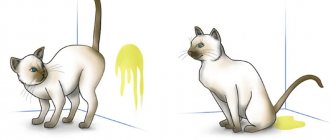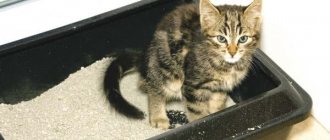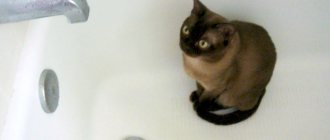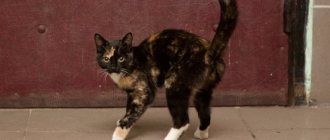The suffering of people whose cat began to shit in the wrong place is immeasurable. Most often in such a situation, the owner's bed and shoes, the threshold of the front door, the corners of rooms and the space under the bathroom suffer. You want to solve the problem as soon as possible, but in a hurry you can only make it worse: by not following the rules, it is easy to reinforce the animal’s erroneous behavior. We will tell you how to stop a cat from going to the toilet in the wrong place.
Why did the cat start shitting in the room?
The first thing you need to understand is why the cat began to upset its owners:
- This may be due to diseases of the gastrointestinal tract or genitourinary system.
- It is possible that the animal attracts attention in this way, showing that it needs help.
- Sometimes a cat’s toilet begins to be associated with pain. In this case, any attempts to return it to the tray will remain in vain until it is completely cured.
Important! If a cat experiences pain, pain or simply unpleasant sensations, if it cannot restrain involuntary urination, then educational measures are useless. In this case, urgent assistance from a veterinarian is necessary: a timely diagnosis and proper treatment will help solve the problem.
Main reasons not related to health:
- a significant change in the situation (moving, renovation, buying new furniture);
- non-acceptance of the premises where the toilet is installed;
- aversion to the smell of the material from which the tray is made (or its shape);
- antipathy to the filler (or its rare replacement);
- conflict between cats living together;
- lack of attention from the owners.
Sometimes an animal takes revenge for an insult in this way or protests if it doesn’t like something. This is his way of “explaining” to the owners: something is not as the cat wants. But there is no need to look for human logic and conscious behavior in such actions: everything is spontaneous, situational and subordinate to instincts.
Our article – rating of trays for cats – can help you with choosing the right accessory.
The reason can be elementary:
- the toilet was moved (turned);
- another cat went into the litter box;
- there is not enough food in the feeder and not enough water in the drinking bowl;
- The family pet is old, and these are age-related problems.
Sometimes a cat stops going because something startled her during a previous trip to the toilet: for example, someone suddenly walked by while the cat was doing her business.
A separate block is the natural need to mark the territory, protecting it from the encroachments of other animals or even guests who come to the house. And also in an effort to attract sexual partners. This is a powerful animal instinct, which cannot be overcome by educational measures.
How to stop a cat from peeing in the wrong place
To accustom a willful cat to the toilet, be patient and calmly persistent: eliminate as much as possible the factors that the fluffy beauty doesn’t like or that bother her.
But if you notice strange behavior and urinary incontinence in your kitty, then this could be feline urological syndrome (FUS). It's better to go to a veterinary clinic.
Experienced breeders and veterinarians advise using behavior correctors at the initial stage of potty training. There are different drugs. They are based on a smell that can attract an animal or, quite the opposite, scare it away. In this way, the pet develops the correct conditioned reflex to go and poop in the designated area.
Owners make scented mixtures themselves or buy ready-made ones at a pet store.
How to prevent cat misbehavior
You can never be sure of anything with a pet: it is a living creature that may have its own problems and its own views on how its living environment should be arranged. In order to protect your home as much as possible from surprises, the conditions for keeping the animal are thought out even before the mustachioed friend is brought into the house.
The cat loves cleanliness, order and clear organization of space. It would be wise to position the toilet in a way that she likes. Then she will agree to do her business where it is convenient for the owner.
Misbehavior in a cat can be prevented if:
- choose a toilet that your pet will like (even if you have to change several in a row);
- When purchasing a tray, take into account the size of the animal;
- place the tray in a secluded corner with 24-hour access to the room;
- place the feeding area away from the toilet;
- Do not place anything with a strong smell next door.
It is extremely important to clean your cat's litter box frequently:
- every time you change the filler;
- as soon as the smell appears;
- Trays used without filler are washed after each cat’s visit to the toilet.
The litter you choose is the one that suits your cat. They change it without waiting for a strong smell to appear, which is individual for each animal.
Sometimes a cat shits in the room because of helminths: the pain and itching force her to look for a place where she can wipe off the remnants of the discharge. Often she looks for something soft - a carpet, a bed or a sofa. To prevent this from happening, even a healthy cat needs to be given anti-worm medication from time to time.
If your cat has urinary incontinence caused by illness or old age, you can only protect your floors and carpets by buying her diapers. This decision will be the only correct one; it will completely eliminate hassle and dirt in the house.
Correction of kitten behavior
So, if we are talking about a kitten, the pet needs to be taught, and not retrained. In this case, folk remedies that have been proven over the years work great. Monitor the kitten once before it urinates. Don't scold! Blot the puddle thoroughly with paper or cotton cloth. The crime scene must be washed and treated with a chlorine-containing preparation. To be safe, use special repellent sprays.
Place your kitten's litter box in the same room where he went to the toilet for the first time. Pour a little filler and place the same paper (fabric) in the tray. Observe the kitten, as soon as he begins to worry and look for a place to relieve himself - carefully take him to the tray and calm him down. Again, for reliability, you can use special sprays.
Tip: Do not wash your kitten's litter box (if possible) during the first week of training. The baby is looking for a toilet, focusing on the smell. The advice is not relevant if there is a severe helminthic infestation, in which case hygiene is much more important than etiquette.
Methods to Avoid
Measures for raising an animal must be completely safe for its health.
Absolute taboo:
- beating;
- poking your nose into a puddle or pile;
- dousing with water;
- rough pushing towards the tray;
- shout.
All this will only frighten, provoke stress and ultimately have the opposite effect. The cat will become insecure and begin to look through all corners in search of something for which it will not be punished.
A little scolding is necessary, but only if the cat was caught “doing this.” Delayed punishment is pointless, because the cat will no longer understand what the owner’s aggression is connected with.
Sometimes it is advised to lock the cat in a cramped room with a litter tray: if it cannot find another place, it will begin to go there. But this method is also quite cruel. Such treatment can frighten, offend the animal and cause a persistent aversion to the toilet.
Physiological reasons
Let's say that your cat always went to the litter box and started peeing anywhere for no apparent reason. Naturally, such antics will cause discontent, but should cause concern. Cats are naturally very clean and do not tend to dirty their homes. Puddles that appear in the home may indicate a number of alarming diseases, most often we are talking about kidney failure in the broad sense.
Urinary Incontinence – Your cat may not be making puddles on purpose! Typically, animals with urinary incontinence leave wet marks where they sleep or sit. If you notice that your cat has gotten into the habit of peeing on the sofa, first, visit the veterinarian and only then (if the pet is healthy) begin to correct the behavior. The causes of urinary incontinence are associated with injuries or diseases of the spine, inflammatory processes (not necessarily kidneys), and old age. This point also includes congenital ectopia of the ureters.
How to stop a cat from pooping all over your apartment: proven methods
It is not at all difficult to train a small kitten to use a litter tray. But if an adult cat suddenly changes its habits, or the animal is taken from the street, only those who show patience and love will achieve success.
The owner needs to show the cat that he is against him shitting anywhere and take care of cleanliness:
- the dirty floor is immediately washed and disinfected;
- it is possible to use an odor repellent;
- soiled shoes are thoroughly cleaned and put away.
Many cats urinate in one litter box and defecate in another. In this case, the problem can be solved in the easiest way: just place two containers next to each other.
If the cat is left alone for a long time, you will have to get another potty, because this animal will not go into a dirty container.
Sometimes it is enough to change the brand of litter to the one the cat is used to. If there is a need to accustom the cat to a different litter, the change is made gradually, mixing the new brand with the old one in increasing proportions.
After making sure that the animal is healthy, you can apply educational measures:
- give a treat every time the cat goes into the litter box: to positively reinforce correct behavior;
- put a bowl of food where it is pooped: cats do not go to the toilet where they eat;
- in cases where “you can’t stock up on any bowls,” you can lay out dry food in areas that have been thoroughly washed of urine or feces beforehand.
If the cat gets into the habit of walking on any object that can be removed for a while (a rug, a chair), then it is better to take the thing out altogether or stop the cat’s access to the room. But it cannot be guaranteed that, having stopped shitting in the wrong place for some time, even for a long time, the cat will not eventually begin to use this thing as its toilet again.
A very effective way for a small kitten is to soak a cloth in his urine and put it in the tray. The smell will point the animal to the right place. The same can be done for an adult cat brought from the street.
A good method is to place the tray where the cat began to shit, gradually moving it to where the owner needs it. Often the cat obeys or does not notice the change in the position of the potty. But sometimes you have to come to terms and permanently move the tray to the corner chosen by the animal.
You can make a place favored by a cat inaccessible:
- cover with something that is better unpleasant for the paws;
- fence with a strip of double-sided tape;
- make inaccessible (fence, cover).
Sometimes it turns out to be effective to create a situation of discomfort at the moment when the cat settles down in the corner of its choice (unexpected appearance, clapping of hands). But the animal always understands that it is doing something bad, and tries to do it when no one is around. The owners will have to keep watch, and perhaps more than once.
To prevent a cat taken from the street from marking the entire apartment, you can collect its scent on a porous fabric (by rubbing it on the fur, for example) and spread its pieces around the apartment. Then the animal will understand that this is its territory, which does not need to be marked.
To prevent pets from spraying gonad secretions and urine around the apartment, males are castrated and females are sterilized. But if this is done late, when the behavior has already become entrenched, the operation will not get rid of the marks. Your veterinarian will help determine the correct age for this procedure.
An animal that shits in the wrong place in order to find a sexual partner can simply be given the opportunity to satisfy its instinct, and silence and cleanliness will return to the apartment.
There is one more absolute rule: a cat’s misdeed, committed in front of the owner, should never go uncondemned. Because the cat must clearly understand what is acceptable in its behavior and what is not.
To educate or retrain?
It’s not hard to guess that in a timely manner solves many problems . There are a number of ways to train a cat to use the litter box and even the toilet; there is only one “but”: this must be done on time. The optimal time does not depend on the age of the pet, but on the length of time it has lived in your home. That is, it doesn’t really matter whether you adopted a kitten or an adult cat; you need to teach it “toilet etiquette” immediately after moving to a new home.
The first and main success factor is choosing a suitable tray . The size, depth and design itself are important. For training, it is better to use open, deep trays with sides and without a mesh. In some cases, cats ignore open litter boxes and then the only alternative is to buy a bio-toilet (a house with a roof and a litter box).
The second factor is filler . Speaking in a global sense, litter for cat litter boxes can be divided into: sand, sawdust and other means. Everything is clear with the first two, the third is granules with a certain moisture-absorbing chemical composition (most often silicone). In some lines there are fillers with flavorings.
Some owners prefer to accustom cats to sand (construction sand), paper, sawdust (not pressed) or soil the old fashioned way. There is some meaning in this, but we will talk about this below.
Important! If you are adopting a declawed adult cat, it will likely be painful for her to step on any litter! In this case, the pet is immediately accustomed to a tray with a mesh.
Protecting your home with special tools
The industry produces many products for correcting animal behavior. At the pet store you can choose them in the form of a spray, powder, or emulsion.
There are drugs whose composition:
- attracts to the tray;
- scares away from the wrong place;
- deodorizes, neutralizes odors;
- disinfects;
- calms during heat.
If in doubt, you can contact your veterinarian, who will advise the most suitable drug for a particular breed and age of the animal. The fact is that some of them act differently on young or old, healthy or sick, castrated or giving birth animals. Only a specialist can choose an effective and harmless remedy for a specific pet.
How to treat the area
To remove the smell of urine and feces, simply thoroughly wash the area where the cat pooped with dishwashing detergent. Often this measure is sufficient and after a short ventilation the smell of feces disappears. If it does not disappear after washing, then try using cologne or perfume with a strong smell. It is not recommended to use “Whiteness” for treatment, since its smell only attracts animals.
You can use industrial products to combat unpleasant odors. You can buy them at a household chemicals store, and some at a pet store.
Traditional methods of dealing with the smell of cat urine
Cats have lived alongside humans for about 10,000 years. During this time, people managed to pick up odors that discourage cats from shitting where they shouldn’t. Not all of them are effective in our time. Moreover, each cat’s sense of smell is individual.
But you can, hoping for a positive effect, spread it out in places that have been washed from excrement:
- lemon, orange (you can put the peels in flower pots);
- mustard or very hot pepper;
- burnt paper or ashes;
- the owner's sweaty clothes.
Cat urine odors from objects, furniture, clothing and shoes can be eliminated using:
- iodine;
- alcohol;
- hydrogen peroxide.
As for bleach and vinegar, they are dangerous to health and completely useless: most likely, they will attract the pet even more to their favorite corner. Simply because they enhance the smell of urine.
What smells repel cats?
Cats are very sensitive to odors, so you can treat the damaged area with a certain product or solution so that in the future the pet does not relieve itself there.
Citrus
You can place orange or lemon peels in corners that are off-limits to your pet. For furniture, a polish with a citrus scent is suitable.
Vegetables
Cats don't like the smell of garlic and onions. To scare away the animal, you can grate these vegetables and place them in the right place, or fill them with water and wipe the surfaces with the prepared solution.
Perfumery
Pets are most sensitive to strong and persistent aromas. But here everything is individual. In addition, to scare away you need to use a large amount of perfume.
Essential oils
Some essential oils are disgusting to animals. Rosemary, lavender, mint, and citranella extract are great for these purposes. Oil is added to water and dripped onto the desired place so that the cat does not go there again.
Essential oils can be mixed with grated citrus peel or coffee grounds; such compositions will scare away your pet.
Some essential oils are disgusting to animals
Herbs
To repel, you need to prepare a decoction: pour boiling water over the leaves of rosemary, cayenne pepper, and lavender and let it brew. Using a spray bottle, spray onto desired areas.
Some spices repel cats: mustard, coriander, cinnamon, ground pepper, cumin.
Chemical substances
Cats have a negative attitude towards various chemicals: varnishes, shampoos, construction chemicals, detergents with a strong smell. You should use all this carefully so as not to irritate your cat’s nasal canals.
Vinegar
Vinegar occupies a leading position. A small drop of this product is enough to repel your pet.











